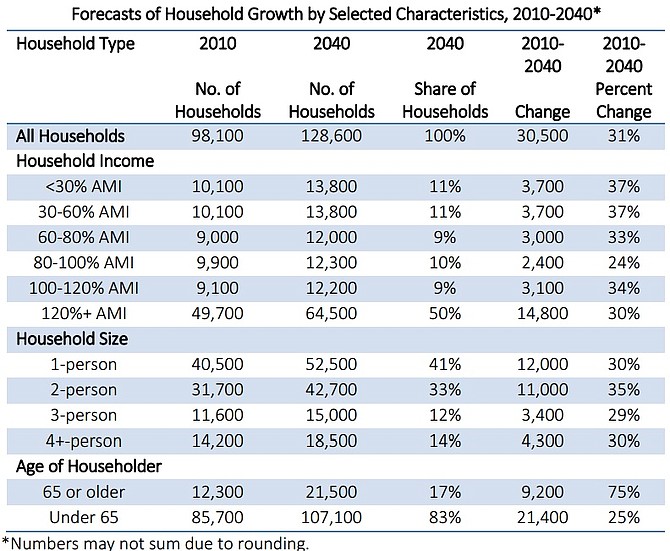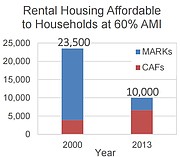County Board moves forward on Affordable Housing Master Plan despite citizen objections. Graphic Contributed
After nearly five hours of public comment and debate, a request to advertise the Affordable Housing Master Plan for public hearings throughout July was approved by the County Board in a 4 - 1 vote. Following the public hearings in July, the County Board will vote on adoption of the plan in September. The culmination of two years of study and drafting, the Affordable Housing Master Plan presented the County Board with a set of goals and a framework for implementation. However, while the plan received support from various commissions and citizens, it also received a fair amount of criticism.
The Affordable Housing Master Plan was endorsed by the County Board in 2012 and an 18-member working group, composed of county government and local community representatives, began meeting in February 2013. The focus of the Affordable Housing Master Plan was to be on identifying and quantifying current and future needs, assessing housing strategies and programs, and to examine and revise the existing affordable housing policy.
The plan starts with an assessment of current affordable housing availability and recent trends. According to county records, between 2000 and 2013, Arlington lost 13,500 housing units that were affordable to low-income families and individuals. In 2013, there were 17,136 households with incomes below 60 percent area median income and 9,565 units affordable at that rate. By 2040, Arlington will be required to have 22,800 renter households, an increase in 6,300 households and a 17.7 percent total of all Arlington households.
The plan also hopes to end homelessness by 2040, reducing it to 200 by 2020. Current surveys from the county report that homelessness has fallen from 461 in 2011 to 291 in 2014.
Of new ownership created between 2015 and 2040, the Affordable Housing Master Plan proposes that 17.7 percent of housing be made affordable to households living below 60 percent of area median income.
The plan identifies funding sources in the Affordable Housing Investment Fund, federal and state housing programs, and bond financing. The plan imposes no immediate financial commitments by the county, but the staff report on the plan does. The Affordable Housing Investment Fund, AHIF, is a revolving loan fund composed primarily of loan repayments from projects across the county (45 percent of the AHIF budget), developer contributions (15 percent of the AHIF budget) and general revenue financing from the county (23 percent of the AHIF budget). Between FY2010 and 2014, AHIF averaged $8 million in public funding. In the FY2015 budget, that swelled to to $13 million.
However, some in the public commented that the plan’s financing remained vague regarding financing outside of AHIF.
“Except for the Tax Increment Financing, which removes revenue from county-school revenue-sharing funds, there are no ongoing added/new revenue streams that will sustain the increases in annual operating costs/subsidies needed to cover increases for county-supplied housing grants and growth in school enrollment,” said Suzanne Sundburg. “The unspoken but obvious conclusion is that significant additional and ongoing taxpayer support will be needed.”
Supporters of the plan on the County Board argued that the plan’s framework presents a list of options, not demands.
“We haven’t signed a blank check that says ‘go forward and do all these things,’” said County Board Chair Mary Hynes.
However, the introduction to the document specifies that “the county’s ability to meet the goals of the Affordable Housing Master Plan will depend on the future allocation of resources to programs identified.”
Implementation of the project was a key concern for many of the five commissions that spoke at the meeting.
“No plan is effective if not fully implemented,” said Joan McDermott, chair of the Commission on Aging. “The plan is not clear as to who or what department in the county will be given the overall responsibility, authority, and resources to fully implement the plan.”
Stephen Sockwell, a member of the Arlington Planning Commission, told the County Board that the commission had approved of the plan but not without substantial objections. According to Sockwell, while the intent of the plan received broad support from the members of the commission, dissenting comments were raised about areas where the plan was unclear.
“[Members of the Planning Commission] felt that the study should contain more prioritization,” said Sockwell. “What policies were important and what policies did they want to see implemented first as opposed to those that were more aspirational in nature.”
Sockwell said members of the Planning Commission also felt that the plan was lacking in analysis of the impact of increased affordable housing in Arlington on other local policies. As in the Planning Commission, the objective of supplying more affordable housing in Arlington received near universal support, but the lack of impact analysis was the primary concern for the majority of the public comment.
“Even if the plan were complete, I would still urge you to vote ‘no’ on this item,” said Liz Odar, a resident of Douglas Park in South Arlington. “The master plan will have long lasting effects on the county. Housing policy is school policy.”
Odar lamented that the public hearings were scheduled to be held while school was on vacation and PTAs were not active.
“This issue deserves the comments of people across our community,” said Odar.
“The county has failed to provide any assessment of the potential costs and impacts,” said Rick Epstein, who identified as a 20-year resident of Arlington. “The plan could commit Arlington to adding up to 15,000 subsidized housing over the next 25 years. There is no analysis of how to pay for this or analysis of the impact on the already overburdened schools. [The county] needs to provide a detailed analysis on other county services, our neighborhoods, and our taxes.”
However, some in the community spoke up in defense of the plan and urged local citizens to be accepting of affordable housing residents in their communities and in their schools.
“Regarding the school problems, some in our community are saying: it’s the wrong perception,” said Chakradher Mishra “Intelligence and manners don’t come by economic [status]. Everyone can be intelligent and a great person in the community if we’re inclusive.”
The Planning Commission will hold a public hearing on the Affordable Housing Master Plan at its July 6 meeting and the County Board will hold an additional public hearing on the plan at its July 18 meeting.

